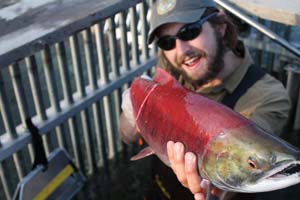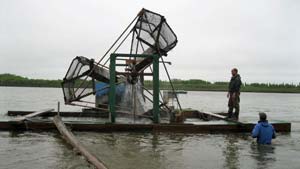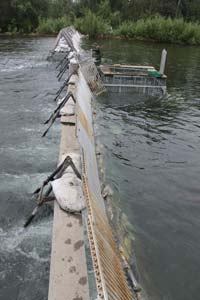Kevin Bassett, College Intern II
Commercial Fisheries - Aniak

In my junior year at the University of Montana, I applied for an internship with the Alaska Department of Fish & Game. My major is wildlife biology with an aquatic concentration as well as minor in wildland restoration. I've always had a deep interest in water, from rivers and lakes to estuaries and the open ocean. I decided to pursue a degree in aquatic wildlife biology because of these interests and because I wanted to protect these opportunities for the enjoyment of generations to come.
I was selected as an intern working as part of a large-scale mark-recapture study of sockeye salmon. We were located on the massive, turbid Kuskokwim River, the second largest river in Alaska. We operated two fish wheels a little downriver from the village of Aniak. Our main objective was to tag all the sockeye salmon that were caught by the wheels. For those unfamiliar with fish wheels (and I certainly was), they essentially consist of three giant, netted baskets that spin in the current, sandwiched between two long, parallel pontoons. The fish are scooped up by the baskets, dropped onto a wooden chute, and slide into a live box that sits in the river. Some of the tagged sockeye salmon will be recaptured at weirs on spawning tributaries upriver. Finding the proportion of total fish tagged at the wheels, to the amount of tagged fish recaptured at the weirs, and then comparing these numbers to the total number of sockeye moving past the weirs, can paint a fairly accurate image of how many sockeye are moving up the Kuskokwim.
It's hard to describe the expectations I had when coming to Alaska. I realized that I would be working on huge river with large salmon runs, and that a lot of people in remote villages that line the Kuskokwim River relied on these salmon. I knew I would learn how to assemble, maintain, and deconstruct not only two large fish wheels, but also a whole field camp. I thought Aniak would be a lot more remote, and was impressed by the amount of people and activity. Not that Aniak isn't remote - it's still a long flight to the hospital - but as far as Alaska goes, it's not unusually remote. Working in such a setting challenges you to think beyond your conceptions, and understand a different way of life. Being immersed in a brand new setting, surrounded by the people who rely on your work, is an incredible feeling.

The first days in Aniak, I was flooded with new information and new skills - from First Aid/CPR to fish identification, bear and camp safety to boat maintenance.
Once the camp was set up and the fish wheels constructed, our days consisted of two shifts of four 'checks', where we drove the boats to each wheel and used a large net to scoop any fish in the live box. We would tally the number and species of each, but sockeye, as our target species, received special attention. This came in the form of measuring the length, recording the sex, and plucking scales so the fish can be aged. For a genetic sample, we took a clip of the axillary process, a small, seemingly superficial appendage next to the pelvic fin. Finally, we tagged each sockeye twice under the dorsal fin, one tag with a number, and the other with a different color and no number.
Camp life was really enjoyable. In between the checks, there was always something to do: splitting firewood, doing inventory, cleaning the boats, raking up and cutting weeds, gathering wood for fires, repairing tools and camp amenities, general cleaning, and whatever else was on our 'to-do board' in the cook tent. We took turns cooking meals and never went hungry. On rainy days, we drank coffee and played rummy while the woodstove roared and rain streamed off the roof.

My first-hand experience in the interactions between managers, subsistence users, and other stakeholders was something I'd only ever learned about in classes and textbooks. My internship at the Kuskokwim River fish wheels was incredible - fun, exciting, and invaluable, as a student in fisheries biology. I was a witness to the interesting season of salmon runs, first hand, as the fish wheels are used to index the number and species of fishes moving past them.
I was immersed in the relationship between salmon and human ecology, as a part of a bigger, connected landscape. The knowledge I gained, the people I met, and the experience I had was the result of an incredible educational and personal experience given to me by ADF&G. The knowledge I gained from this internship will certainly help me in my fisheries career.
